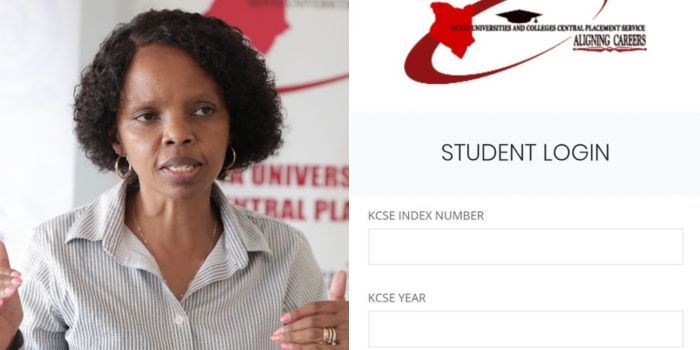KUCCPS Application Guide: How to Maximize Your Chances of Securing a Preferred Course.
To improve the chances of being placed in their desired programs, the Kenya Universities and Colleges Central Placement Service (KUCCPS) has issued guidance emphasizing the importance of aligning applications with specific course requirements.
Students were advised to select courses at institutions where the previous year’s cut-off points are lower than their own cluster weight. This increases the likelihood of being admitted to preferred programs.
Understanding Cluster Weight and Cut-Off Points
Cluster weight is calculated based on a student’s performance in the four core subjects relevant to a given course. On the other hand, the cut-off point represents the weighted cluster score of the lowest-ranked student admitted into that program in the previous intake cycle.
KUCCPS pointed out that the inclusion of previous year’s cut-off points is aimed at helping applicants choose courses with a realistic chance of admission based on competition trends.
Using the Portal to Identify Eligible Courses
To make informed decisions, applicants were directed to compare their cluster weights—accessible via the KUCCPS portal—with the cut-off points from the 2024 intake. The portal’s “All Programmes” page includes a search feature that allows students to look up specific courses by typing in relevant keywords like Education, Agriculture, or Clothing. This functionality is designed to help users quickly locate programs they qualify for.
Meeting Minimum Subject Requirements
KUCCPS urged students to be diligent in confirming they meet all minimum subject requirements before selecting any course. They reminded applicants that only programs for which a candidate meets the academic criteria can be applied for. After identifying suitable courses, students should note down their program codes and rank them in order of preference, starting with the most desired.
Submitting the Application and Making Payment
Once the preferred programs are selected and entered in the designated slots on the portal, students are to submit their choices and proceed with a payment of Ksh1500. This marks the final step of the application process and ensures the selected courses are officially submitted for consideration.
Application Timeline and Eligibility Window
This update comes shortly after KUCCPS reopened its application portal for the 2024 Kenya Certificate of Secondary Education (KCSE) candidates. The portal went live on March 28, enabling students to apply for degree programs and Technical and Vocational Education and Training (TVET) courses. KUCCPS announced that the portal would remain accessible for 21 days, with the application period closing on April 21.
Who Can Apply and for What Programs
In the official communication, KUCCPS confirmed that the application process targets 2024 KCSE candidates for degree programs, while those who sat for the KCSE between 2000 and 2024 are eligible to apply for TVET and Teacher Training College (TTC) courses.
Step-by-step instructions for a successful application
To initiate your application, you must submit it online through the KUCCPS Student’s Portal. This can be accessed by visiting students.kuccps.net or navigating through the official KUCCPS website at www.kuccps.ac.ke. After accessing the site, one should click the “Login” button at the top right corner and provide the required login credentials as requested on the form.
After logging in, applicants are advised to click on the Programme Lists tab found on the menu bar. This allows them to download essential documents, including the available Degree Programmes list and the Degree cluster guide. These resources outline the Degree courses on offer, the respective universities, the subject requirements, and the 2023/2024 cut-off points. These documents should be used for reference when selecting Degree courses.

Additionally, applicants are encouraged to consider the previous cut-off points to assess their chances of placement. To make informed choices, they should compare their portal-displayed cluster weight against the 2024 cut-off points. For better chances, candidates are recommended to choose universities where the cut-off points for a given programme are below their cluster weight.
Viewing TVET Courses
To explore Technical and Vocational Education and Training (TVET) courses, applicants need to click on All Programmes, which opens a categorized listing by qualification level: Degree, Diploma (Level 6), Certificate (Level 5), and Artisan (Level 4). By clicking on the desired level, one can view the programme codes, minimum entry requirements, and offering institutions.
If searching for a specific course, the portal also offers a Search Tool, where users can type a keyword such as “Agriculture”, “Education”, or “Clothing” to find related programmes.
When deciding which courses to apply for, applicants should ensure they meet all the minimum subject requirements before recording the relevant Programme Codes. Only those courses for which the applicant satisfies the requirements should be selected.
Once ready to apply, users should click on the Application tab and then select Apply Now. They must input the Programme Codes in order of preference. The top three choices (1a, 1b, 1c) must represent the same course in three different institutions. This should be followed by other courses in decreasing order of preference.
After entering all chosen Programme Codes, users should click Submit. At this point, the portal will prompt them to respond to a placement option. If they agree to be considered for alternative courses in case none of their choices is successful, they should select ‘Yes’; otherwise, select ‘No’.
To proceed, click Submit again. The system will now prompt payment of Ksh 1,500 and provide available eCitizen payment methods. Applicants should choose their preferred option and complete the payment.
It is important to log out upon finishing, which can be done by clicking the Index Number on the top-right corner of the portal.
Payment Process
Once payment is completed, users must return to the portal and click the I have paid button. They should then enter the eCitizen Payment Reference code in the designated slot and press Submit.
For M-PESA users, there are two payment methods:
- STK Push: Input the payer’s mobile number and send. A prompt will appear on the payer’s phone to enter their M-PESA PIN. After payment, an SMS will be received with the eCitizen account number, which should be entered in the appropriate field before submission.
- Manual Payment: Use the M-PESA menu on the phone, following instructions on the portal’s payment page.
Read Also: MP Pushes for TSC Dissolution Over Promotion Bias
After payment, users must click I have paid again to return to the submission page and input the eCitizen Payment Reference Code, which is identical to the account number. It is essential to note that this code will also be needed for any future application edits. Applicants must avoid using the M-PESA transaction code in place of the required reference.
Upon successful payment and submission, the system will display a confirmation message stating the application has been submitted. Additionally, an SMS confirmation will be sent to the applicant’s contact number provided during the process.
For further assistance, applicants may contact KUCCPS at 0205137400 / 0723954927 or send an email to [email protected].
KUCCPS Application Guide: How to Maximize Your Chances of Securing a Preferred Course.
Follow Teachers Updates on Facebook, LinkedIn, X (Twitter), WhatsApp, Telegram, and Instagram. Get in touch with our editors at [email protected].



Discussion about this post